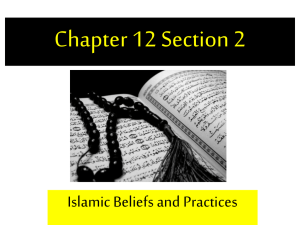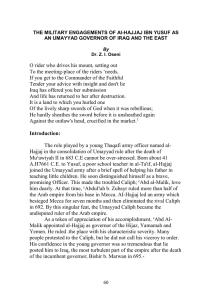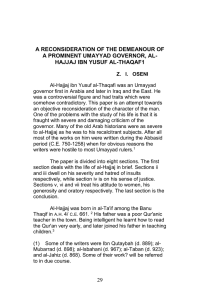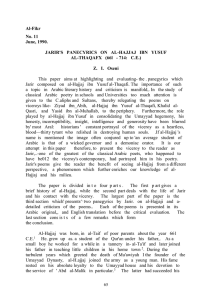AN EXAMINATION OF AL-HAJJAJ B. YUSUF AL-THAQAFPS MAJOR POLICIES Z. I. OSENI
advertisement
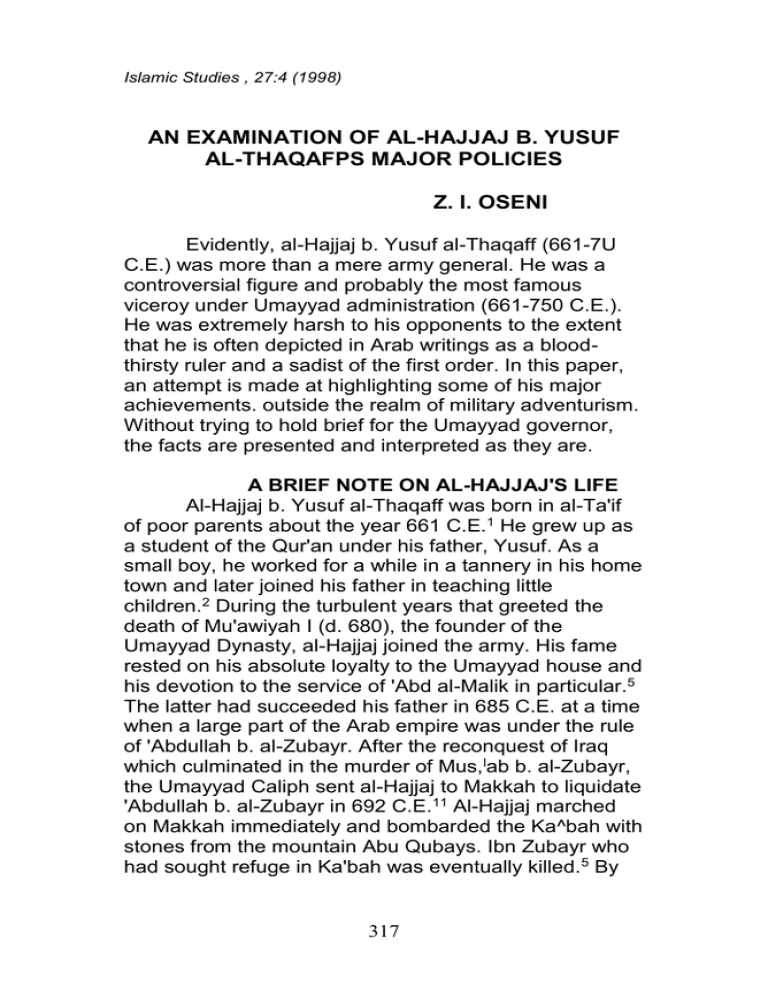
Islamic Studies , 27:4 (1998) AN EXAMINATION OF AL-HAJJAJ B. YUSUF AL-THAQAFPS MAJOR POLICIES Z. I. OSENI Evidently, al-Hajjaj b. Yusuf al-Thaqaff (661-7U C.E.) was more than a mere army general. He was a controversial figure and probably the most famous viceroy under Umayyad administration (661-750 C.E.). He was extremely harsh to his opponents to the extent that he is often depicted in Arab writings as a bloodthirsty ruler and a sadist of the first order. In this paper, an attempt is made at highlighting some of his major achievements. outside the realm of military adventurism. Without trying to hold brief for the Umayyad governor, the facts are presented and interpreted as they are. A BRIEF NOTE ON AL-HAJJAJ'S LIFE Al-Hajjaj b. Yusuf al-Thaqaff was born in al-Ta'if of poor parents about the year 661 C.E.1 He grew up as a student of the Qur'an under his father, Yusuf. As a small boy, he worked for a while in a tannery in his home town and later joined his father in teaching little children.2 During the turbulent years that greeted the death of Mu'awiyah I (d. 680), the founder of the Umayyad Dynasty, al-Hajjaj joined the army. His fame rested on his absolute loyalty to the Umayyad house and his devotion to the service of 'Abd al-Malik in particular.5 The latter had succeeded his father in 685 C.E. at a time when a large part of the Arab empire was under the rule of 'Abdullah b. al-Zubayr. After the reconquest of Iraq which culminated in the murder of Mus,lab b. al-Zubayr, the Umayyad Caliph sent al-Hajjaj to Makkah to liquidate 'Abdullah b. al-Zubayr in 692 C.E.11 Al-Hajjaj marched on Makkah immediately and bombarded the Ka^bah with stones from the mountain Abu Qubays. Ibn Zubayr who had sought refuge in Ka'bah was eventually killed.5 By 317 Islamic Studies , 27:4 (1998) this action, al-Hajjaj removed the greatest threat to the Umayyad rule. As a reward, al-Hajjaj was made governor of the Hijaz, Yemen, and Yamamah. After a two-year rule, he was sent to govern Iraq and the East-an area which was the most turbulent in the empire. In early 695, he stormed Kufah and began his reign of terror. It was really a reign of terror, but when viewed against the Iraqis5 hate of the Umayyads, their belligerence and fickleness, one is obliged to consider the governor's severity with some sympathy. Afterall, such severity is a lesser evil than anarchy and lawlessness.6 Some of the insurrections he had to crush included those of the Kharijites, Ibn Jarud and 4Abd al-Rahman b. al-Ash'ath.7 Al-yajjaj descended heavily on the Iraqi malcontents and massacred them, thanks to the constant reinforcements which he received from Syria when necessary.8 ATTITUDE TOWARDS ISLAM AND CONTRIBUTION TO ARABIC AND ISLAMIC CULTURE Al-Hajjaj's extreme severity in treating his subjects notwithstanding, he was a Muslim, and normally his attitude towards religion, especially Islam, affected the manner in which he ruled Iraq and the East. He led the congregational prayer himself as the Chief Imam. On Fridays he addressed the congregation in a pious tone, admonishing the Iraqis to eschew evil deeds and to obey the Umayyad government. In this manner, he regarded the Umayyad Caliphate as God's own Caliphate.9 In one of such sermons, he says inter alia "O People, to abstain onself from what God forbids is easier than (being compelled) to exercise patience in God's punishment".10 As a devout Muslim, he abstained from superstition and fanaticism in the practice of Islam, and was never moved by the endless controversial dialectics of theologians of the various political camps.11 318 Islamic Studies , 27:4 (1998) Besides personal profession of Islam, al-Hajjaj helped to improve Arabic orthography to facilitate the reading of the Qur'an. At the time of his taking over the Governorship of Iraq in 695, Arabic orthography was still at its rudimentary stage of development. It was made up of consonants alone with hardly any satisfactory vowel marks. To compound the situation there were many identical consonants without any diacritical points or other marks to differentiate between them. The result was that many non-Arabs and the new generation of city-dwelling Arabs who were not well versed in the Arabic language made serious mistakes in the reading of the Qur'an. It is true that the scripture was recorded in the Prophet Muhammad's life-time, compiled into a volume during the reign of Abu Bakr, and further redacted and circulated in Caliph 'Uthman b. Affan's reign. But, as has been noted, the Arabic orthography at the time created problems for people. It was difficult to differentiate between Arabic letters like To facilitate the reading of the Qur'an therefore, there was a dire need to supply marks to distinguish between the letters. First, witnessing the incorrect reading of the Qur'an, one Abu '1-Aswad al-Du'alT alBasrf (d. 688) had to supply some vowel marks in Arabic language. By this effort, he was able to reduce serious grammatical errors which were increasingly becoming a cause for concern among the intellectuals of the time. AlDu'alt represented fathah (the vowel 'a*) with a dot in a colour different from the colour of the ink in which the material was written. Dammah (the vowel V) was 319 Islamic Studies , 27:4 (1998) represented by a dot in front of a letter while a dot under a letter represented the kaMak (the vowel (i). In addition the nasal sound (al-qkunnah] was represented by two dots.11 The scanty inflectional marks Introduced by alDu'air were not enough to solve the problem of mispronunciation of written Arabic. So al-Hajjaj commissioned one of his scribes named Nasr b. 'Asim al-LaythT to supply the diacritical points to distinguish between indentical letters.14 A second version of the story, however, says that Nasr b. 'Asim al-Laytht and Yahya b. Ya’mar (d. 129/747) were the ones entrusted with the responsibility of supplying the consonantal marks of differentiation. *5 This source also claims that the job was completed not later than the year 757. 695 when Yahya b. Ya*mar was sent to Khurasan by alHajjaj for detecting a minor grammatical error in the viceroy's speech.16 Al-Hajjaj was one of the few people of his time who hardly committed solecism in their speeches and writings; but when Yahya, a brilliant philologist, discovered one or two instances when the governor made mistakes, the latter cleverly appointed the former a judge of Marw, the KhurasariT capital - a case of subtle banishment from Iraq.17 A third version of the story mentions Yahya b. Ya'mar and the famous ascetic, al-Hasan al-BasrT (d. 110/729), the scholars whom al-Hajjaj charged with the responsibility of supplying the marks.18 The third stage in the improvement of Arabic orthography was the supply of maddah (mark of prolonging a vowel) shaddah (mark of doubling a consonant), hamzah (the gluttural stop), -iukun (a mark of absence of a vowel), and wasl. (a mark of eliding a gluttural stop, especially in the a/ (the) of definiteness). The Arab/Islamic society had to wait till the 8th century to get the above items supplied. It was Khali b. Ahmad al-Farahfdi (d. 786) who supplied them. He is the one 320 Islamic Studies , 27:4 (1998) who put most of the marks in their present shape. Khalil was a creative scholar, for he is also remembered today as the father of Arabic lexicography and Arabic prosody.19 It is also related that al-Hajjaj was the one who divided the Qur'an into thirty equal parts called ajza' (singular, juz') 20 to facilitate the reading. This division is recognized ail over the Islamic world. To this day, Muslims who read over the Qur'an as a matter of routine every month, read a part (juz) everyday. Athough the story of the supply of vowels and consonantal marks to the Arabic language has many versions, one fact which stands clear is that al-H.ajjaj b. Yusuf's name is always cited in connection with this achievement. This is a testimony to his reform capability and the use in which he put his knowledge of the Qur'an acquired in his youth in al-Ta'if.21 By his foresight, pragmatism, seriousness, and sagacity he was able to improve Arabic orthography and provide a uniform mode of reading the Qur'an in particular and any Arabic material in general. He made this new orthography the authoritative one and forbade other variant manners of reading the Qur'an which were enunciated by the scholars in Iraq, the most prominent of which was Ibn Mas'ud's version.22 Perhaps, the viceroy's action was a reaction to the cynical attitude of some of the scholars of Iraq to the viceroy's commendable reform. They forbade the adoption of his innovation as regards the text of the Qur'an 2 3. In the end, it was al-Hajjaj 's will that prevailed. Significant too, was al-Hajjaj's introduction of the Mamil to grace the rites of the pilgrimage to Makkah. The Mahmil or mahmal according to T.P. Hughes, is a covered litter borne on a camel from Cairo and Damascus, to Makkah, as an emblem of royalty at the time of the pilgrimage. 321 Islamic Studies , 27:4 (1998) It is said that Sultan Az-Zahir Baybars, King of Egypt, was the first who sent a Mahmal with the caravan of pilgrims to Makkah in A.D. 1272 but that it has its origin a few years before his accession to the throne...24 This is one of the many stories about the introduction of the mamil to the ceremonies of the pilgrimage. However, ancient Islamic sources such as alMadfun by Ibn Qutaybah (p. 274.) and at-K.anz atMad$u.n by al-Suyuti (p. 68) states that it was al-Hajjaj who first initiated the practice of sending the mahmil to Makkah. In the modern times, however, the WahhabT rulers of Saudi Arabia have abolished the mahmil as it is regarded by them as "a relic of heathenism",25 not in any way sanctioned by Islam. There is at least one occasion on which they intercepted a caravan which accompanied a mahmtL26 It should be noted that puritanism and a return to the unalloyed, pristine principles of Islam are the mainstay of Wahhabism*7; therefore, one should not be surprised at the Wahhabis' abolition of the makmil. THE MINTING OF ARABIC COINS Sequel to the consolidation of the Caliph 'Abd alMalik's grip on the Arab empire, he settled down to initiate reforms of far-reaching effect. In 695, the Caliph began his monetary reforms and struck new Arabic coins for the first time in the history of Islam. Al-Hajjaj followed suit and minted pure Arabic coins first at Kufah and later at Wasit, his new capital. The officer in charge of the work was a Jew called Sumayr; hence the coins were sometimes referred to as al-sumayriyyah The viceroy did not spare anyone who attempted to produce counterfeits. He also punished workers at the mint for any fault in Production .2 9 To him, high quality was an object which must be sought at all cost. 322 Islamic Studies , 27:4 (1998) The new Umayyad silver coins were similar to the last Sasanid ones which they replaced. The crescent, the star and “Blissmillah” (In the Name of God) were imprinted on their margins. One side of the early silver coins bore "the Prophet's blessing" while the other side had the legend "Lillah" (Unto God)10. In addition to the name of God, al-Hajjaj's coins in Iraq and the East bore his own name.31 He carried out this policy with the tacit approval of the Caliph Abd al~Malik; for none of the sources consulted in this research show any indication of disapproval from the Caliph. As was usual with the Iraqi populace who never saw anything good in al-Hajjaj's actions, many of their theologians expressed their disapproval of the governor's coins, and claimed that the money "might fall into the hands of unbelievers".32 Yet they forgot that the Sasanid currencies which the Muslims had been using since the conquest of Iraq had been coins minted by "unbelievers". Now that a Muslim viceroy had minted Arabic coins with the name of God inscribed on them, they resented the attempt and called the coins afdarLahvn at-tnaktdkah (loathsome dirhams).33 Nevertheless, in spite of the unwarranted criticism of the coins by the theologians, al-Hajjaj's coins circulated well and helped to stabilize the economy of the eastern provinces of the Umayyad empire.34 AGRICULTURAL AND LAND POLICIES The viceroy knew how devastating the effect of famine could be on the people and therefore evolved significant agricultural and land policies. He implemented these policies vigorously and made the Mawali.35 toil hard for the survival of the economy. Agriculture was a very important factor in the growth of the Umayyad empire. Consequently, al-Hajjaj showed a keen interest in this occupation and ensured its development. This interest is glaring iri the interview which the viceroy once had with an Azdl bedouin farmer 323 Islamic Studies , 27:4 (1998) who came from 'Umman. The governor asked him about the best crop in the land. The farmer replied that the best crop was the one with a thick stalk, widespread foliage, big grains and long ears. The viceroy then asked him about the best type of grape. Without hesitation the 'UmanT farmer replied that the best grape was the one with a thick base, a fresh stem, and a large bunch. Asked further what the best type of dates was, the farmer replied that it was the one wijh a thick rind, a small nut, and a thin back."36 In an age that was far less scientific than the modern era, the fear of a devoted ruler like al-Hajjaj of the consequences of famine made him send progress reports about rainfall in Iraq to his sovereign in Damascus. In one of such reports, al-Hijjaj told the Caliph 'Abd al-Malik that after his last letter to the Caliph, there had not been any rain in Iraq except a light shower which could not wet the ground properly. He gave a vivid picture of the suffering of fanners in Iraq and the fear of famine. The viceroy then gave the information about a heavy down-pour which took place during the weekend preceding the writing of the said report. As a result of the intensity of the rain, farmers in Iraq had a cause to thank God for the blessing. In concluding the report, the viceroy said, "Praise be to God Who sent down His rain and spread His mercy after they had lost hope; He is the Protector, the Praise -worthy. Greetings"37 The viceroy constructed canals in the lower Euphrates and Tigris to drain marshes. By this action, he reclaimed fertile land suitable for agriculture. Wherever an embankment broke down, he got it repaired as quickly as possible -regardless of whatever it cost him." The governor was strict in land matters, for he knew that land was the first and major factor in agricultural practice. He gave uncultivated hectares of 324 Islamic Studies , 27:4 (1998) land to some worthy Arabs such as Qutaybah b. Muslim's brother, Bashshar as fiefs.39 In order to ensure a steady flow of Kharaj (land tax), he took a decision which is wrong from the Islamic point of view, and he was vehemently criticised for it. The MatooS felt that as Muslims they had to pay only the Zakah (poor rate). They resented the viceroy's policy which envisaged that the treasury would soon become empty as a result of the acceptance of Islam by the conquered non-Arab peoples in thousands, if nothing was done to stem the tide. As a measure dictated by the economic situation in his domain, al-Haijaj imposed the khafiaj (land tax) on the MawalT, thus disregarding their new status as Muslims. Thus it became obvious that the non-Arab Muslims could not be treated by the Umayyad rulers as the compeers of their Arab counterparts. The Mawali, soon discovered that they could not evade this tax. Al-Hajjaj called them Barbarians, drove them out of the cities to which they had migrated in large numbers, and sent them back to their fields.40 He got the names of their villages branded on their hands for easy identification.41 They were made to till the land as before, and pay the land tax which sometimes amounted to one fifth of their total crops harvested from the land in addition to the poll tax (jizyah).42 When the farmers complained that, as a result of years of war, the land had become desolate, the viceroy forbade them from slaughtering their cattle so that they could thereby preserve the animals for ploughing and probably supply the manure required in the farms.43 Al-Hajjaj's oppressive attempt to drive the Mawair back to their farms ultimately occasioned resentment and indignation, and proved unworkable.44 One can understand why the Mawali. joined other forces to destroy the Umayyad regime in 750. 325 Islamic Studies , 27:4 (1998) CONSTRUCTION OF A NEW CAPITAL, WASIT As a result of the constant intrigues of the Iraqis, especially in the two main cities of Basrah and Kufah, alHajjaj decided to build a new capital in the area about the year 702. His choice fell on a spot midway between Kufah, Basrah and Ahwaz. Hence he named the town "Wasit:" (a medial town). 45 The governor built this fortified capital in order to keep the majority of his Syrian troops detached from the rebellious Iraqi population. Ostensibly, he built the town so as to save the people from encroachment on the part of Syrian’ troops 46 whom the Iraqis hated because they were veritable representatives of the 'oppressive* regime of Banu Umayyah. The city was built on the west bank of the river Tigris. The eastern side was formerly occupied by a town called Kaskar-known in Aramaic sources as "Kashkar". The viceroy destroyed many towns and villages and used their doors and other materials in building Wasit.47 The construction of the city began with a mosque, beside which the government house was built. The house had a high dome known as al-qabbat at-KkadKd' (the Green Dome). The city's roads to the neighbouring towns had large gates. Al-Hajjaj also built a mighty jailhouse known as at-VwaA.** The city was surrounded by a ditch and two walls. In all, the viceroy spent an estimated amount of 43 million d&ikamA on the project. This amount, according to Bahshal, was up to the total amount realized from land tax in Iraq for five years.49 The western part of the town was a fortified garrison which no one could enter except through the city gates. The governor did not allow strangers to pass a night in the new city. By sunset those who came to transact their business in the city had to leave and the city's inhabitants who had gone out had to return. Moreover, 326 Islamic Studies , 27:4 (1998) the governor did, not allow any outsider to enter the city without a pass. There were sentries at each gate.50 The city was beautiful and had a better climate than Basrah. According to al-Dinawart, Iraqis used to visit the place for pleasure; hence there were many inns in it. In the field of learning, the city produced many erudite scholars such as Bahshal al-Wasiti (d. 292/905) 51 al-Khatib al-Baghdadi, Ibn al-JawzT, and Ibn al-Athir.52 Ibn Battutah described the people of Wasit in the 14th century C.E. as the best in Iraq. He said that many of the scholars in the town learned the Qur'an by heart, and that they read it with excellent intonation. Consequently, according to him, outsiders thronged to the town to study the Qur'an.53 After al-Hajjaj's death, the town continued to expand until it became one of the major centres of the Islamic world. This expansion further enhanced the density of the population of the Tigris - Euphrates Basin.54 Wasit continued to be the most important city in Iraq throughout the Umayyad era. It was, however, overshadowed during the 'Abbasid period by Baghdad and Samarra, though it did not lose its military importance in the southern and middle parts of Iraq. When al-Mansur started the construction of Baghdad, he removed the gates of Wasit and used them. He also imitated al-Hajjaj in the construction of a central mosque, a palace, and a green dome. Wasit is considered today as one of the most important monuments of Islam in Southern Iraq.55 The people of Wasit were proud of the mosque and dome of al-Hajjaj. When the light-houses fell in 497/1104, the people of Wasit wept and lamented in such a manner that surpassed mourning a dead person, according to Ibn al-JawzT.56 Wasit, suffered greatly at the hands of the Mongols when they destroyed Baghdad in 656/1258. Hulagu descended on the city with his army and pillaged, massacred, and enslaved the inhabitants 327 Islamic Studies , 27:4 (1998) of the town. Furthermore, Wasit suffered at the hands of Timur Lank in 795/1394, a man who destroyed its monuments, the great mosque, the government palace, and the Green Dome.57 Over the centuries, the waters of the Tigris had receded and the river had changed its course near Wasit; it flows at present by the town of al-'Amarah. Wasit and the neighbouring towns consequently shrank and were later deserted by the inhabitants from the early part of the 12th century A.H./l8th century C.E.58 The town is now in ruins. Excavation work started at the site in the Autumn of 1939 and continued till 1942.59 CONCLUSION An attempt has been made in the foregoing discussion to evaluate the reform policies of al-Hajjaj b. Yusuf al-Thaqaff, the prominent Umayyad governor whoin spite of his ruthlessness in dealing with his subjectsmade significant contribution to the Arab and Islamic culture. It has been established that notwithstanding his severity and other weaknesses, al-Hajjaj was a devout Muslim. He led Muslims in prayer as an Imam and believed that obeying him and his Umayyad over-lords was tantamount to obedience to God and His Apostle, Muhammad. Under his direction the Arabic orthography was improved to facilitate the reading of the Qur'an. To the present writer, this is the greatest achievement of alHajjaj. He also made the pilgrimage to Makkah more buoyant and colourful by the introduction of the Mahmil though the latter has been abolished by the puritanical Wahhabis of Saudi Arabia. Al-Hajjaj, as we have noted, also carried out monetary reforms by minting purely Arabic money like his sovereign, the Caliph ‘Abd al-Malik. Their coins were the first purely Arabic/Islamic coins in history. In the 328 Islamic Studies , 27:4 (1998) realm of agriculture, the viceroy introduced reforms to enhance food production for the people. But by so doing, he made the Mawali bear the burden and compelled them to pay taxes which Islam does not sanction. Thus economic expediency forced him to disregard Islamic laws in imposing the poll tax and land tax on the Mawali Finally the construction of a new capital, named Wasit, is one of the most lasting achievements of alHajjaj. Though the town is now in ruins, it constitutes one of the oldest Islamic monuments in Iraq today. All in all, al-Hajjaj's achievements do testify to his greatness, as an Arab figure in the Umayyad era. Very few Caliphs could boast of what he attained in his life. He was extremely ruthless in treating his enemies; but his benefits he bestowed on the Umayyad society were far greater than could be claimed by some other ruthless governors and army commanders of the Umayyad period. Herein lies his special place in Arab history. NOTES AND REFERENCES 1 A Dietrich, "Al-Hadjdjadj ibn Yusuf" in The. Encyclopaedia o£ 1-i/am. New Edition, Vol. III. (Leiden; E.J. Brill, 1970) p. 40. Henceforth this work will be referred to as E.I. 2 'Abd al-Latif Shararah, A/-Hajjaj Taqhtyat of-' Alab. (Beirut: Dar al-Makshuf, 1950), p. 81; 'Amr ibn Bahr, alJahiz, AP-Bayan wa y.-Tabtjln, Vol. 1, 3rd Edition (Cairo; Maktabat alKhkniji and Beirut: Maktabat al-Hilal, 1968), p. 202. 3 Shararah, op. CAt.r p. 87, Mahmud Taymur, Ibn Jafa. (Cairo: Dar alMa'arif, 1965), pp. 13-25. 4 Muhammad ibn Jartr al-TabarT, Taiikh aPRu&u/ wa 'f-Mu/ufe ed. 329 Islamic Studies , 27:4 (1998) Muhammad Abu '1-Fadl IbrahTm. (Cairo: Dar al-Ma'arif, 1964), p. 174. 5 Al-TabarT gave details of al-Hajjaj's march on Makkah and the various incidents which took place. Ibid, pp. 187-92. 6 See Al-Hajjaj's speechss on this issue in Ibn 'Abd-Rabbihf, A 'Iqd at-fa ud, Ed. Karam al-BustanT, Vol. xv. (Beirut, Matba'at al-Manahil, 1953), PP. 129-32. 7 See Dietrich, op. tit., p. 40; P.K. Hitti, Hitf.oiif oi thL AiabA, 10th Edition. (London, Macmillan, 1970), p. 208; L.V. Vaelieri, "Abd al-Rahman ibn al-Ash'ath", E.I. New Edition, Vol. 1, pp. 715-19- See also M. Al-Faruque,"The Rebolt of 'Abd al-Rahman ibn al-Ash'ath. Its Nature and Causes," Wamn. Stud&A, vol. 25, 3(1986) 289-304. 8 Ibid., p. 717. 9 See Ibn 'Abd-Rabbihl, op. xv, pp. 125-26. 10 See al-Jahiz, op. cit., vol. II, p. 303. 11 Dietrich, op. cit., p. 42. 12 Prior to the introduction of dots to distinguish between these identical letters, it was extremely difficult to comprehend fully the import of any written text as many ways of reading and interpreting it were possible. 13 Muhammad HaqqT al-NazilT, Kkazinat alAssar Jalilat al-adhkan. af-Adhka. (Cairo, 'Abd alHamid Ahmad Hanafr, 1286/1869), p. 14. Ibid., p. 14 15 Sabah 'Abbas Salim, 'lsa Ibn althagati:Nahwuhu min khilah Qira’atihi 1st Edition. (Baghdad, Dar al-Tarbiyah, 1975), p. 20. 16 Ibid., p. 20. 330 Islamic Studies , 27:4 (1998) 17 T.P. Hughes, Pictwnaiy o4 Warn. Revised Edition. (Lahore, The Book House, 1964), p. 686. 18. Ibid., p. 686. 19. See Hitti, op. cx£, p. 242. 20. Al-Nazill, op. cit., p. 14. 21. For more details on al-HajjSj's role in the revision of Arabic Orthography, see Ibn Khallikan, Waiayat afA^an wa An6as Abna' al-2amS.n, ed. Ihsan *Abbas, Vol. II. (Beirut Dar al-Thaqafah, 1971), p. 32. 22. Dietrich, op. ctf., p. 41. 23- Hughes, op. c&., p. 686. 24. Ibid., p. 306. 25- Hitti, op. cit, p. 136; Ahmad (A1T alQalqashandi, Subk aP-AAha'fc Stna'af aJL-lMka.', Vol. 1, (Cairo, Wizarat alThaqafah wa ' 1-Drshad al-Qami, 1936), p. 428. 26. Hughes, op. Ct., p. 307. 27. For details on the WahhabTs, see Cambridge. HJAtoiy of, Lsfem; Tfte Ce.nhat I4&mc Land. Vol. I, edited by P.M. Holt, A.K.S. Lambton and B. Lewis. (London, C.U.P., 1970), pp. 380-1; Hitti, op. ct., pp. 74041. 28. Dietrich, op, cot., p. 41. 29. Ibid., p. 41. 30. A. Levy, The. Soow£ Sttutctu/ie. of IVam. (London, Cambridge University Press, 1969) p. 304. 31. Ibid., p. 304. One side of the coin bore Surat-f (Chapter; 112 of the Qur'an). See al-Qalqashandf, op. ut., I, p. 424. 32. Dietrich, op. cit., p. 41. 33Ibid., p. 41; Al-QalqashandT, op. c#., 1, p. 42434. Dietrich, op. cit, p. 41. 35. The Mawali singular, mawla) were clients who were non-Arab Muslims under the protection of powerful Arab tribes. As Muslims they deserved to be treated with their Arab counterparts. But al-Hajjaj would not do this. 331 Islamic Studies , 27:4 (1998) For more on the Wawd^c see Hitti, op. CA£., pp. 218-19, 232-3336. Al-Jahiz, op. cit, vol. II, p. 146. 37. ibid Vol. IV, pp. 99-100. 38. Dietrich, op. cxf., p. 41. 39. Ibid., p. 41. 40. Ibid., p. 41. 41. Levy, op. cit., p. 58. 42. Ibid., p. 58. When the Basran scholars saw this they wept over the disregard of Islamic regulations on the part of al-Hajjaj. See Ahmad Amm, fayi , al- islam 10th Edition. (Beirut, Dar al-Kitab al-'ArabT, 1969)' p. 92. 43. Dietrich, op. cit, p. 41. 44B. Lewis, Tfce faab* -in HJAtoty, 4th Edition, (London, Hutchinson University Library, 1968), p. 77. 45. Dietrich, op. Cit., p. 41. The governor built the city after seeking the permission of the Caliph. See Aslam ibn Sahl al-Razzaz al-WasitT Bahshal, T&ukh WaMt ed. Gurguis 'Awwad. (Baghdad, Matba'at al-Ma'arif, 1387/1967), p. 43. 46. Dietrich, op. cit., p. 41. 47. Bahshal, op. cit., p. 23. 48. Ibid., pp. 23-25; Naji Ma'ruff al-Madkkal ft. Taukh al-Hadaiat af-'Arabiyyah 5th Edition. (Baghdad, Matba'at Wizarat al-Tarbiyah, 1965), p. 220. 49. Bahshal, op. cit., p. 22; Naji Maruf, Wadaris. (Baghdad, Matba'at al-Irshad, 1966), 98. 50. Ibid., p. 8. 51. The author of TaiAkh WdMt referred to in notes 45, 47 and 49 is the one mentioned here. His book, according to Awwad, was the first history work to be written on Wasit, and, in fact, one of the first on the cities of Islam. See Bahshal, op. cit., p. 9. 52. Ma'ruf, Madotti..., op.cit., p. 9. 53. Ibid., p. 9, quoting Ibn Battutah, Rtkfah, p. 183; Bahshal op. cit., pp. 25-26. 54 Ma'ruf, Madaris.., op, cit, p. 10. 55 Idem., Ai-MadkhaL.., op. cit., p. 221. 56 Idem., M-Madkhat..., op. cit., p. 221.10 332 Islamic Studies , 27:4 (1998) 57 58 59 Ibid p 11 Idem., M-Madkhat..., op. cit., p. 221. Idem., Madaris..., op. cit., Bahsal, op cit pp 27-28. 333



